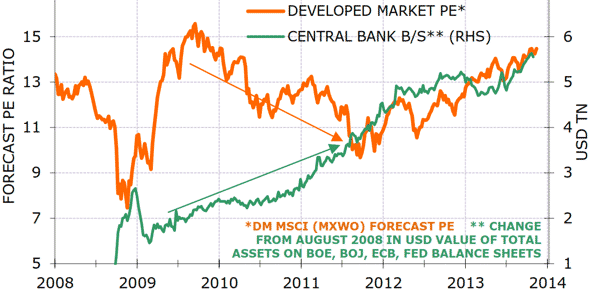What will a Fed taper mean?
Today’s commentary
The big policy and market issue today is Federal Reserve policy. There is widespread interest in today’s FOMC meeting because of the possibility that the Fed could taper the pace of its large scale asset purchase program. But why is there this interest? I believe it is because of the signal effect of tapering and nothing more. Explanation below.
At this time last week, I professed doubt about the Fed’s intentions on December tapering. The consensus seemed to be building around comments by St. Louis Fed President Bullard that a ‘tiny taper’ in the LSAP program was the right market signal. But comments by Philadelphia Fed President Plosser made it seem like we could also wait until a later date to taper in order to please the doves and then do so more aggressively to please the hawks.
All of this taper talk seems a bit excessive. The market is not all about QE. Niels mad a good point in his last monthly newsletter on valuation:
If QE was solely responsible for the re-rating of equities that has taken place, one would expect a strong correlation between P/E ratios and the size of central banks’ balance sheets throughout the post-crisis period (i.e. from early 2009); however, P/E ratios actually contracted during the first two years of QE (chart 6). In other words, QE alone does not explain the recent bull-run.
[…]
Chart 6: QE vs. equity market valuation
Source: Minack Advisors
So if QE is not the sole thing driving valuation higher, why does it matter? Well, let’s look the intersection of what QE is and how long-term interest rates are derived.
First, “quantitative easing is simply large scale asset purchases (LSAP) by the central bank. The central bank is permitted by law to purchase a wide range of assets including but not limited to Treasury securities, mortgage-backed securities, or municipal bonds” (How Quantitative Easing Really Works, March 2011). And it really is not clear that QE drives down interest rates at all. During QE1 and QE2, the increase in inflation expectations actually increased interest rates during QE, driving rates moderately higher despite the signalling effect of accommodation and the reduction in the term premium.
I think this gets into how long-term interest rates are derived because they are really a series of short-term interest rates. And these series of short-term rates are future overnight rates, that reflect only market-determined median expectations of future Fed Funds rates plus a risk premium. After we put these short-term rates together to derive the long-term rate, we can then decompose the long-term rate into expected inflation, a real interest rate and a term premium, the risk premium for holding longer duration assets instead of contracts for money deliverable tomorrow
QE is about shifting that risk premium. The Fed has told us so repeatedly. But it is also about signalling accommodation and about when the Fed will change its federal funds rate. So QE has some residual impact on expectations of future Fed Funds rates.
The Fed doesn’t like QE any more. The term premium is about as low as its going to get. So QE has served its purpose. Now, the Fed wants to move over to forward guidance as a policy tool because it wants to focus on altering rate expectations (especially given the desire to eventually normalize policy). And so tapering is really all about this shift from focusing on the term premium to focusing on interest rate expectations.
When the Fed tapers then, I expect the Fed to also signal ease regarding forward guidance. And I also expect the market to listen to this guidance because the Fed’s credibility on guidance is now such that the market is less likely to front-run the Fed’s guidance. That means I do not expect the market to shift forward its view of when rate hikes begin just because the Fed tapers. Rather, I expect most or all of any yield backup to come from the increase in the term premium. And so QE is really about risk on versus risk off.
What a Fed taper means is that the risk-on trade is no longer a good trade and that punters need to rein in their risk, their leverage, and their duration. Bond market guru Bill Gross is already doing so. Stock market guru Jeremy Grantham is also already doing so. The Fed’s tapering is telling us this is the right way to proceed. So while I don’t expect a massive selloff like we got in May when tapering was first mooted, I expect yields could back up. But, the taper signal is not about yields, its about the risk of holding long duration assets like equities, high yield bonds, convertible bonds, and leveraged loans. These are the assets that will be most affected by a risk premium-induced yield curve steepening.

Comments are closed.